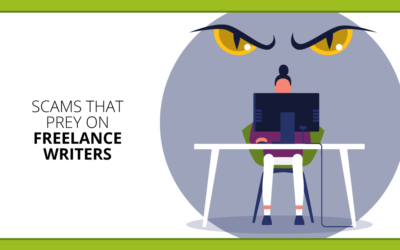Do you believe it’s the lot of the freelancer to have ‘drought’ months with no income?
Well, it doesn’t have to be that way. That’s not my normal.
Don’t know if I’ve ever shared this before, but I never had a zero-income month, in over a decade of paying all my bills entirely from freelance writing gigs.
I didn’t have the option of having drought months, because for many years, I was the sole support of a family of five. Terror clawing at my gut at the idea that a month might come along with no money in it.
So I designed my freelance life so that I always had money coming in, every month. Because my mortgage was due every month, too. And my kids weren’t interested in taking a month off of eating.
How did I do it? Well, there are some fundamental steps that always-booked freelancers take that most writers don’t bother with. Now that I coach writers in my Den 2X Income Accelerator Program, I’ve seen how reliable and powerful these steps are for taking a writer from just scraping by to earning a major income.
If you’d like to banish ‘down’ months from your freelance life, here are the basic steps you need to take:
Change your mentality
To be a fully-booked freelancer, you have to first believe it’s possible. If you accept the conventional wisdom that as a freelancer, sometimes you’ll be broke and desperate to take any crummy gig that comes down the pike, then you will likely have some months with little or no income.
Add a few of those months into your year, and it’s pretty hard to make your freelancing add up to a nice living.
Instead, begin with the assumption that steady freelance income is possible. Commit yourself to achieving fairly stable revenue for your business, and you’ve taken the first step to getting there.
Never stop marketing
I wish I had a dime for every time a writer told me this:
“I had this big assignment and I was working on it for months, and now it’s over. And…I don’t have any work! I was too busy to do any marketing, and now I’m scrambling.”
Now hear this: You are never too busy to do marketing, as a freelancer. Marketing is one of your core functions, as it is with any other type of business.
Your goal when you have a lot of work is to find ways to squeeze in at least small bits of marketing, every week. Maybe for you, that means catching one in-person networking night a month, or sending one query a week, or sending introductory InMails weekly to prospects who’ve viewed your LinkedIn profile. But whatever form it takes, you need to keep at it.
Constant marketing keeps prospective clients calling on you. That means when one gig ends, you’re more likely to have new work lined up.
Build strong inbound marketing tools
If you hate marketing and you’re tired of having to churn out scads of letter-of-introduction emails (or don’t have time), there’s a solution. Create a great writer website and LinkedIn profile. Keep updating your site so Google loves it. Then, let these online tools bring you a steady stream of quality inquiries.
You’ll notice I didn’t say to rely on your UpWork or Fiverr profile or Craigslist ads or any other bottom-feeding place. Your own website is your chance to communicate: “I’m a pro.” While your presence on low-pay marketplaces says, “I’m cheap and desperate.”
Many writers don’t seem to believe they can really get found online with their writer website, and so don’t invest time in developing these virtual assets. But I’ve seen success story after success story for writers who prioritize making these pages sharply focused on your ideal client.
Having a strong inbound lead-generation machine takes you from scrabbling around for any gig at any price to picking and choosing among your inbound offers. Not only do your odds of avoiding a ‘down’ month improve, but the quality of gig you get will likely be better, too.
Seek ongoing gigs
One trait common to all low-earning freelance writers I’ve ever met is that they do tiny gigs. They write one blog post for $50 or $100, or a few web pages for $300. Then that gig is over, and they have to find a new client.
This is not the route to a stable income. You’re spending too much time ramping clients and too little time earning. Before you know it, you’re back beating the bushes for another client. And looking worriedly at the calendar, wondering how you’ll pay your bills this month.
Stop taking small, one-off gigs from tiny magazines or businesses, and look for the clients that can sustain you. They are usually bigger. They have real editorial or marketing budgets, and the ability to assign you work every month.
Many of the top-earning writers I know only accept ongoing retainer gigs. So don’t write one blog post — look for the client who’ll assign you 4 posts a month, every month, all year.
Stay diversified
There’s a big freelance pitfall I call One Client Syndrome. You land one big client, get all excited…and forget to keep your business diversified. You only have the one big client, for months. Then the gig suddenly ends, and eek! You have no work.
Remember, if you only have one client, then they should be paying you a full-time salary with vacation and sick leave. It’s not really a freelance gig. They’re owning all your time.
Successful freelancers have a diverse stable of clients, so that when one gig ends, there are other assignments still ongoing. That’s your vaccination against a zero-income month.
Upsell your clients
When’s the last time you asked one of your existing clients if they needed a higher-paid type of writing — a long feature article, a new free report for their blog subscribers?
Upselling is routine in many industries, but it’s the rare freelance writer who considers upselling a regular part of their marketing.
It’s easier to get a bigger project from an existing client than from a brand-new one. Part of your job as a freelancer is to always be looking for ways to grow the relationship with your current clients. Don’t wait for them to ask you — reach out and make it happen.
Ask for referrals
One of the easiest forms of marketing is asking people who already know and love your work if they would keep an ear out for X type of writing gig for you.
Yet, few writers I ask about this report they have ever asked their network for referrals. Much less, that they are deliberately growing their network so that they have more people they can ask.
Asking for referrals is one of those great micro-marketing things you can do when you’re super-busy. Only takes a minute to hit one former editor or marketing manager, or one writer-friend, and tell them who your ideal client is and what sort of writing you like to do.
The request for referrals can often take a few months to play out, so it’s not always a great strategy if you’re broke and desperate right now. But throwing that request out there while you’re busy can work great for delivering you some leads a month or three later, when that current gig ends.
Be a fully booked freelancer
Do you know what the three best words are for driving up your freelance rates? They’re “I’m fully booked.”
Once you’re booked up, you instantly become more desirable to new prospects. You tell them you could maybe find time to do their gig in 6 weeks, and they go nuts. (I’ve had prospects wait those 6 weeks to get me, too.)
You go from just another writer among millions to the only writer they want. Your fee is no longer the primary consideration — you can pretty much name your price.
That’s the true magic of never having ‘down’ months. It doesn’t just mean you have steadier income, but usually, that you can command higher rates and earn more from every gig you get. It’s worth a little work to get there.
Are you fully booked? If not, let’s brainstorm ideas to make it happen on Facebook or LinkedIn.











